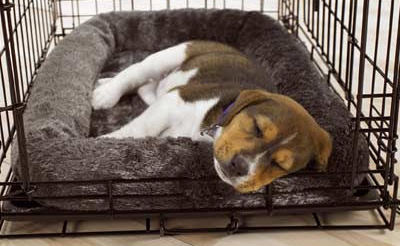
There are many ways to house train a new puppy. Each method comes with its own set of challenges and rewards. One of the most popular and effective practices is to use a crate as a training aid. The term “crate training” has been coined to describe this practice.
One of the most crucial parts of puppy training is that you develop a praise and reward system for your dog to let them know what is a good behavior. Training a puppy to do anything at all also requires a good amount of time and bonding, the more time you spend with your pet, the less time it will ultimately take to train them.
The trick to effectively house training a puppy is to incorporate a routine that focuses on increasing the chance that your pet will “go” when you are standing with them. This will give you a chance to properly praise and reward them in the moment. It also allows you to monitor where they are relieving themselves, so that you can dictate what location is a “good” place and what location might be a not so good place to do so.
Another important aspect of house training is to make arrangements for your puppy when you are not there to supervise them. Until they are fully house trained it is not the best idea to allow them free run of your house. This typically results in little “surprises” being left pretty much anywhere and everywhere. Confining a pet to a small area, to begin with, such as a bathroom or kitchen will allow you to better prepare them for house training and will make their messes a little easier to clean up. So where does the crate come in?
What is Crate Training?
Dogs, in general, do not like to soil the place that they sleep as long as they have an opportunity to relieve themselves in another location. Temporarily confining your puppy to an enclosed area will inhibit their tendency to just go wherever and whenever they please. If they prefer not to urinate in their crate then they are more likely to do so when they are let out which not only keeps your carpet a little cleaner but also gives you the opportunity to be present when they “go” so that you can give them the proper praise and reward.
The purpose of crate training is “short term confinement.” It is intended to keep your puppy from relieving themselves when they are confined, so that when they are eventually released from their crate and taken to an appropriate area they can freely do so. Crate training puppies is also a way to teach your pet to have control over their bladder and bowels, so that they can successfully hold them when they are in an area where that is not acceptable and will be able to wait until certain scheduled times of the day.
Crate training puppies can be done a wrong way and should not be abused. Otherwise, the problem may get worse and worse. Crate training is not intended as a way to lock up your pet and forget about them for extended periods of time. If your new puppy soils their crate because you left them in there for an unreasonable amount of time, you are only setting the training process back several weeks or more.
How Do I Crate Train a Puppy?
Start off by only confining your puppy to a crate when you are at home with them. At first, you will need to give your puppy a chance to relieve themselves every hour or so during the day. Let them out, put them on a leash and take them outdoors immediately. Once you have them outside, take about 5 minutes to let them root around and try to eliminate.
If they fail to “go” within that 5 minute period just return them indoors and put them back in their crate. If they succeed then immediately praise them and give them something they like as a reward. You can even let them run around the house freely for the next little while. After 45 minutes you should try to take them out again, as it is never a good idea to let them roam freely if they do not have a completely empty system.
This process will become more natural as time goes on. Try to keep a diary of when your puppy is eliminating. Keeping a fairly strict feeding schedule can help these periods of elimination more uniform. You will eventually notice that your puppy tends to “go” at certain times during the day and you can start to only take your puppy out at these specific times, as opposed to every hour.
Once you have their schedule figured out you can begin placing them in the crate about 1 hour before their next bathroom break. This will stop them from going earlier then the scheduled time. With a lot of consistency and dedication on your part, your puppy will become more and more reliable about relieving themselves when and where they are supposed to. Eventually you can reduce time spent in the crate and even do away with it all together.
About one hour before she needs to eliminate (as calculated by your diary) put her in her crate. This will prevent her from going earlier than you had planned. With your consistency and abundance of rewards and praise for eliminating outside, she will become more reliable about holding it until you take her out. At this point, the amount of time you confine them before their scheduled outing can be reduced, then eventually eliminated.
Crate training puppies is a practice that many pet owners use to help new dogs adapt to their environment and teach them how to behave properly. As with any training method, there is definitely a right and wrong way to do it. It is important that you are familiar with the basics of the process so that you can do it effectively and help your pet rather than cause them any harm or bad habits.
 |
Crate training puppies is a practice that many pet owners use to help new dogs adapt to their environment and teach them how to behave properly. As with any training method, there is definitely a right and wrong way to do it. It is important that you are familiar with the basics of the process so that you can do it effectively and help your pet rather than cause them any harm or bad habits. |
| Russ Barker knows that house training a new puppy can be very tedious and challenging, which is why he wanted to better inform the public about the proper method of crate training puppies. Russ is the creative mind behind almost every single blog article published by DogTagArt.com, a fun and exciting website that focuses on pet safety while also keeping style in mind. They have hundreds of pet ID tags each with a unique full-color design. These unique custom dog tags are nothing like the standard boring metal ID tags that have been around for decades. They are the future of pet identification. |  |

